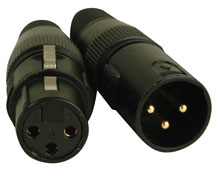Table of Contents
DMX Cables and Cabling
If you have read the the What is DMX? then you will know that DMX cabling should be done with 5-pin XLR connectors.
The main reason for this is so you cannot accidentally connect a “sound” 3-pin XLR connector to the circuit as this could cause serious damage to either the fixtures, the DMX interface or the “sound” equipment.
But I am sure that most users use the 3-pin DMX cabling system. I know I do and infact I do not have any fixtures that are 5-pin. The only sign of 5-pin connectors I have are on my 2 x Enntec USB DMX Pro interfaces, my VisualDMX interface and on my two DMX splitters that have both 3-pin and 5-pin in and 2 x 3-pin and 5-pin out.
Please also be aware that some lighting fixtures require 5-pin cables to operate properly, these are some of the most expensive fixtures around and the extra 2 cables are used for a variety of reasons, some use them as power lines, some use them as spare data lines and some use them for their own proprietry reasons.
Do not use cables that are designed for “sound” equipment, buy the best DMX cables you can such as Nuetrik, Cordial or another reputable manufacturer, the cables should be rated around 120Ω.
Ensure any DMX cabling runs are terminated with a DMX terminator regardless of if it works without it. Have spares, you will be supreised how easy it is to loose these.
If you are a mobile lighting rigger then putting colour caps on the connectors of your DMX cables makes it esier to identify, use a different colour for each length that you have. If you have a mixture of 3-pin and 5-pin cables then try to keep them seperate and/or indetify them with different colour caps as well. If have a cross-over cable, needed for some older Martin fixtures, ensure that is also kept seperate or identified in someway.
If you happen to be in a permanent setup then the above is not so important.
Get or make a DMX tester as it saves a lot of time tracking down faulty cables. Can be done with a Multi-meter but that is not as easy as plugging in a DMX tester.
The connectors with the holes are the out, think of it like a power socket, you cannot (would not) put you fingers in the socket and the power comes out of it. The in is the connectors with the pins, again think like a power plug, you can touch the pins and no harm is done and this goes 'IN' to the socket. As can be seen on the picture below, 'DMX OUT' is on the left and 'DMX IN' is on the right.

When connecting your fixtures with cables try to use the shortest cable possible, but not so short that it is stretched.
Try to avoid running near “High” power cables as this could cause interference on the DMX line. Terminating sometimes resolves this problem. It is just something to be aware of, if you are getting problems and all your cables are good and it is terminated check to see if any are running near power cables. I have not had this problem my DMX lines run along the same trussing with my power cables.
You do not have to connect you fixtures in address order they can be in any order you like and if you use a DMX splitter the same applies to that as long as they are on the same universe.
Pinouts
| 5 Pin XLR for DMX 512 | |||
|---|---|---|---|
| Pin | Signal | Description | |
| 1 | Signal Common | Ground (Screen) | |
| 2 | Data Minus | Usually Black | |
| 3 | Data Plus | Usually White | |
| 4 | Spare Data Minus | Usually Green | |
| 5 | Spare Data Plus | Usually Red | |
| 3 Pin XLR for DMX 512 | |||
| Pin | Signal | Description | |
| 1 | Signal Common | Ground (Screen) | |
| 2 | Data Minus | Usually Black | |
| 3 | Data Plus | Usually White | |
| 3 Pin XLR for Martin Professional Protocol (Pre MAC 600) | |||
| Pin | Signal | Description | |
| 1 | Signal Common | Ground (Screen) | |
| 2 | Data Plus | ||
| 3 | Data Minus | ||
| If you have an older Martin Professional fixture that requires this pinout configuration and the rest uses the standard pinout configuration then your best bet is to create a couple of cross over cables that swap pins 2 and 3 on one end of each cable. Ensure you mark these to recoginise them easily and try and make these fixtures the last on the chain or on a seperate chain using a DMX splitter as it can help save any confusion. |
|||
| 3 Pin XLR for Martin Professional Protocol (MAC 600 and later products) | |||
| Pin | Signal | Description | |
| 1 | Signal Common | Ground (Screen) | |
| 2 | Data Minus | ||
| 3 | Data Plus | ||
| Recent Martin Professional fixtures are fitted with a set of jumpers on the main PCB that allow you to reconfigure the pinout of the data connectors. Please consult your user manual to see if your fixture has this option, and for instructions on how to change the settings. |
|||
